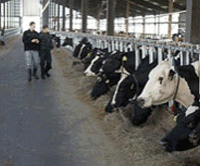 Print
Print
Text Size
Collapse All
-
Bovine Herpesvirus-1 (BHV-1) belongs to the Herpes family of viruses. BHV-1 is highly contagious and can quickly spread through a group of calves. The secretions of affected calves are extremely infectious and appear to be highly attractive to other animals. All ages of animals are potentially at risk. With regard to pneumonia, two other viruses are commonly involved: bovine respiratory syncytial virus and parainfluenza 3 virus.
-
IBR is an acute infection usually characterized by visible signs, including sudden onset of fever, salivation, rhinitis (red nose), conjunctivitis (red, watery eyes), inappetance, and dyspenea (difficult breathing). The nasal mucosa and muzzle are distinctly inflamed, with abundant nasal discharge. Nasal lesions become large, consolidated hemorrhagic (red) areas or white plaques. In advanced cases, respiratory distress increases and open-mouth breathing is evident. If primary BHV-1 infection does not resolve in five to ten days, secondary bacterial infection can occur, leading to bronchopneumonia and death in complicated cases. The reproductive system may also become involved manifested by infertility problems, abortion, and birth defects.
In adult cattle, one of the early signs of BHV-1 infection is a reduction in milk yield.
-
Diagnosis may be made on clinical signs (fever, nasal discharge and conjunctivitis) and epidemiology. Additional examinations are often required for a definitive diagnosis. (E.g. laboratory tests).
In dairy cattle, prolonged drop in milk production, abortion and reduced fertility are also precursory signs.
-
There is no specific anti-BHV-1 therapy. The most appropriate treatment is antibiotic therapy designed to control secondary bacterial infection. Management practices designed to reduce stress, isolate infected animals, and provide adequate food and water will limit disease transmission and severity.
-
The prevention of IBR is based either on preventing the virus from entering the herd or vaccination. Vaccination with modified live virus (MLV) vaccines generally provides adequate IBR protection by helping prevent disease or reducing its severity. Parenteral (intramuscular or subcutaneous) and intranasally administered IBR vaccines are available, with intranasal (IN) products producing a rapid local immune response.
Traditionally, parenteral modified live virus IBR vaccines are not labeled for use in calves nursing pregnant cows because of the risk of shedding of the vaccine virus to pregnant cows, resulting in fetal infection and abortion. (NOTE: Zoetis Bovi-Shield GOLD® FP® and PregGuard GOLD® FP® vaccines are approved for use in pregnant cows or calves nursing pregnant cows provided the cows have been vaccinated prior to breeding.) Intranasal MLV vaccines are safe in pregnant cows because they replicate at the local site of infection rather than systemically.
*LABEL INDICATIONS: Do not use in pregnant cattle (abortions can result) unless they were vaccinated, according to label directions, with any BOVI-SHIELD GOLD FP or PREGGUARD GOLD FP vaccine prebreeding initially and within 12 months thereafter. Do not use in calves nursing pregnant cows unless their dams were vaccinated within the past 12 months as described above. To help ensure safety in pregnant cattle, heifers must receive at least 2 doses of any BOVI-SHIELD GOLD FP or PREGGUARD GOLD FP vaccine with the second dose administered approximately 30 days prebreeding.

